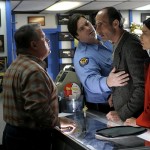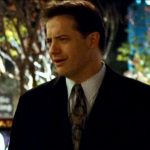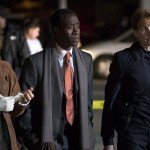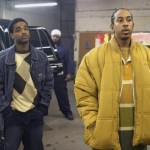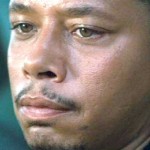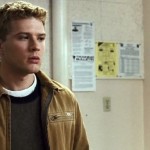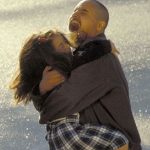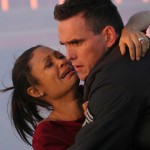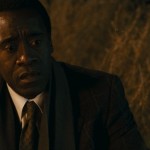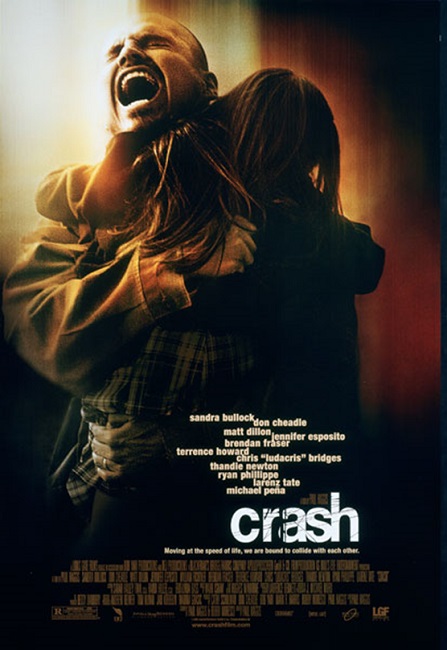
Crash – 2005
RACISM!! RACISM!! RACISM!! In case you haven’t gotten my point yet, this movie is about RACISM!! I was clobbered with the concept. I came away from it feeling like I had, by virtue of being White, been accused of being a racist. It was so strongly shoved into my face that I was almost offended.
The stance that Crash seemed to take is that everybody, without fail, is a racist… especially white people. I haven’t felt like this since watching the Best Picture winner of 1947, Gentleman’s Agreement, which was about Anti-Semitism. But to the film’s credit, even the victims of racism were shown to be racist as well.
Now, if you can get past being preached at and being force-fed the differences between Whites, Blacks, Hispanics, Chinese and Persians, There were actually some fairly interesting stories going on. Director Paul Haggis, who you might remember as the winner of the Best Adapted Screenplay Award the previous year for his work on Million Dollar Baby, made some very interesting choices. He seemed to go out of his way to mislead the viewers at every opportunity. He seemed to look at the popular 1994 film, Pulp Fiction and emulated its eclectic style.
Like Pulp Fiction, Crash didn’t have a strong central plot. Instead the film was made up of a number of individual stories that were thinly connected by tiny threads. Each of those threads touched the wavering line that was the main story, though very little time was given to that story. The result was a tapestry made up of characters that floated in, out and around each other, sometimes touching each other, and sometimes crashing into each other.
The opening scene is that of a Persian man, Farhad, and his daughter, Dorri, played by Shaun Toub and Bahar Soomekh, as they are buying a gun. The owner of the gun store is a racist. When Farhad becomes confused and thinks the owner is cheating him, he becomes angry and the racial insults begin. The owner kicks him out of the store. Dorri completes the purchase and buys a box of ammunition, seemingly at random.
But then the main story kicks in and it is a murder mystery. Don Cheadle plays Detective Graham Waters, a Los Angeles homicide policeman who is called to the scene of a body found on the side of the highway. At this point, we do not know who the victim is.
Then the scene changes to the previous day where two Black men, Anthony and Peter, played by Chris “Ludacris” Bridges and Larenz Tate, are walking down the street in a predominantly White neighborhood. They are passed by a couple, and as they walk by, the woman unconsciously shies away and grabs her husband‘s arm. Anthony comments that the woman is racist and doesn’t even realize it. He says he is offended because she sees a Black man and automatically assumes that he is a criminal. Of course, two seconds later Anthony and Peter pull out guns and car-jack the couple.
The couple are District Attorney Rick Cabot and his wife Jean, played by Brendan Fraser and Sandra Bullock. The story then follows them as they go home and are having the locks in their house changed. A Hispanic man named Daniel Ruiz, played by Michael Pena, is the locksmith. Jean freaks out and gets into a fight with her husband, saying that the locksmith is going to give their keys to his “homies” and she wants the locks to be changed again.
Then the story follows Ruiz as he returns home to tuck his daughter into bed. She is afraid because she has heard a gunshot. Once he gets her into bed, he gets an emergency call to fix a lock in someone’s store. It happens to be Farhad’s store.
Anyway, I could keep going, describing the various plots and stories. Suffice to say that more and more characters are introduced in this fashion. Mat Dillion plays a White racist police officer John Ryan, partnered with Tom Hansen, played by Ryan Phillippe. Terrance Howard and Thandie Newton are the Thayers, a Black couple who are pulled over by Ryan. Loretta Divine is Shaniqua Johnson, the Black insurance representative that denies Ryan’s father’s insurance request.
Then there is… wait… what was the main plot again? Oh, right. The murder mystery. But by this time, I didn’t even care about that any more. I was still trying to figure out what all these separate stories had to do with each other. But the answer was simple, really. You guessed it: racism.
Crash went out of its way to show just how nearly every one of its characters were racist in one way or another. But after a while, I began to realize that it was the whites that were portrayed as the most racist of all. They were afraid of just about everybody, believing them all to be criminals, gang members, and rapists.
The movie seemed to take itself too seriously. There was nothing light-hearted about it. There was no sense of fun or joy. I’m not saying there has to be in order for the film to be good or enjoyable, but when the ending credits started to roll, I was left with a general feeling of anger and futility. It systematically showed me the serious problem of racism and yet offered no solution, no hope of a better tomorrow.
But don’t worry. In the end, at least you are brought back to that main plot. You learn who was murdered and who murdered him. But once again, Haggis takes every opportunity to mislead you. Neither the murderer nor the victim are who you expect.
And as for those misleading aspects of the film, I suppose they are one of the things that made the movie interesting, if not enjoyable. For example, when Dorri buys the bullets in the red box, we naturally assume that they are regular ammunition. But when Farhad eventually shoots the weapon, we think he has accidentally killed Ruiz’s young daughter. It isn’t until later that we learn that the bullets Dorri bought were blanks. We are never told whether she knew they were blanks when she bought them or if it was just a fortunate mistake. The point is that the tragedy was averted, but not through any human virtue. It was just blind luck.
With such a large cast telling so many different stories, nobody really got very much screen-time, especially when compared to a normal linear film. So it is difficult to judge individual performances. Sandra Bullock got the second billing spot behind Don Cheadle, but they were by no means the leading actors. They were probably just the biggest names the film had at the time and they were hoping that they would draw more people to the box-office.
So, the only thing I can do is to pick out the actors whose performances stood out to me. And I’ll also mention one who I felt fell a little flat.
For my money, the actor that stood out the most was Matt Dillon. He played a despicable character whose blatant sexual violation of Mrs. Thayer was disturbing and unforgivable. But in a later scene, when he saves her from a horrible death, he becomes that perfect blend of level-headed thinking and reckless heroics that make him the quintessential police officer. He puts his own life at risk to save hers, despite the fact that she recognizes him as the man who molested her in front of her husband. She initially refuses to let him touch her, but accepts his help when she sees the danger she is in. Again, more misdirection. We are all set up to write Ryan off as a racist pig, but then he turns around and is shown to be a true hero in a life or death situation.
Terrance Howard also turned in a good performance as Mr. Thayer. They set him up as a weak man who often allows people to shower him with racist comments and abuse. But we are misled again. When Anthony and Peter try to car-jack him, he fights back and nearly gets himself killed, not by the two criminals, but by the police officers who show up on the scene. Howard was actually very good in that scene, playing a man who has finally taken too much abuse.
Cheadle is a very good actor and he always does a good job, so I liked the few scenes he was in. He always has a wonderful seriousness about him, yet also an undeniable depth of emotion that lies beneath the surface.
However, Brendan Fraser, I’m sorry to say, fell a little short of his co-stars. He just wasn’t a very good actor. His performance was virtually emotionless. He was paired up with Sandra Bullock, who is a pretty good actress, and she quite easily upstaged him. Part of that might have been the writing, but I think that Fraser’s poor performance had something to do with it as well.
Interesting note: Fraser’s role of Rick Cabot was originally supposed to have been played by John Cusack, who I think would have been a much better choice.
All in all, I’m not sure if I would call this movie Best Picture material. It was a well constructed film, deserving the other two Oscars it took home for Best Editing and Best Original Screenplay, and the acting was fine. It just had too little cohesiveness in the plot and too much anger behind the action. It accused me of being a racist but didn’t offer me any forgiveness or apology, or any hope of redemption. The world is full of bad and horrible people, and it always will be. The end.
Interesting note: The Best Picture win for Crash was actually a fairly controversial issue. It won over the movie Brokeback Mountain, which many people say should have taken home the coveted award. Unfortunately, anti-homosexual discomfort among the Academy members made Crash the “safe” choice. However, some critics stood by Crash as the better movie.
Another interesting note: This really has nothing to do with my critical analysis of the movie, but it was an interesting bit of trivia I found in my research. Crash was the last Best Picture winner to be released in VHS format, and the first to be released in Blu-ray Disc in the United States.
